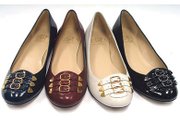Retailers Find Hazards and Profits in Wholesale
After more than 20 years of owning Los Angeles–based boutique chain The Wasteland, Cheryl Cohen and Joe Swinney started their own line of high-end men’s T-shirts, Quintessence of Dust, in 2005. The frustrations they felt from retailing hardly compared with the grief from their first year of manufacturing, Cohen said.
“Basically, we’re starting over again. It’s a new business with a new learning curve,” said Cohen, who juggled running the three Wasteland stores with starting the fashion label.
The schooling could be harsh. She and Swinney cut precious time from their bread-and-butter boutique operation. They were forced to postpone the debut of a women’s line for Quintessence after two catastrophic events. The lead designer quit four months after they started the line in October 2005. Then, in August 2006, their women’s-line samples were delivered in the wrong colors the night before a crucial sales event, the Project Global Trade Show.
But the partners in business and marriage refused to quit their entire manufacturing venture, and they’re getting closer to their goal. After the February Project show, more than a dozen retailers, including New York–based boutique Lounge, purchased Quintessence of Dust menswear. Cohen plans to wholesale this line, with retail price points of $50 to $100, to more boutiques across the United States.
If successful, the gambit undertaken by The Wasteland co-founders might pay other dividends besides having to buy one less line for their boutiques. Manufacturing could build a new profit center for their business. Their fashion label may turn into a powerful branding tool for their stores.
Their venture to the other side of the apparel industry is becoming a more familiar one to retailers across California and the United States. While no statistics exist to quantify the number of retailers who try manufacturing, educational organizations such as the nonprofit Fashion Business Inc. said more retailers have been taking their manufacturing classes, according to FBI President Frances Harder.
Well-known retailers such as Kitson and American Rag have licensed their names to fashion lines that are sold at high-profile department and specialty stores such as Macy’s, Nordstrom and Pacific Sunwear. Yet burgeoning Los Angeles contemporary boutiques such as Satine, Jill Roberts, Apartment 3 and Xin—as well as The Closet, based in Newport Beach, Calif.—recently started fashion lines. Their new labels may give them a precious competitive edge, according to Jeannie Lee, founder of Satine.
“A multi-line shop can be duplicated,” Lee said. “But if you have your own intellectual property, it is harder to duplicate. It gives a brand a lot more weight and value. If you’re the designer, your store always will be two steps ahead.”
A successful fashion line can lend a retailer street credibility that cannot be purchased with a high-cost marketing campaign, said Lee Trimble, fashion director of New York–based Gen Art, a producer of events dedicated to emerging fashion and arts. “It’s like a walking advertisement,” she said of a store’s fashion line.
Yet, the price of entering into the world of manufacturing is high. Funding a new clothing label can cost $250,000 after considering the costs of manufacturing, staffing and marketing the line, according to manufacturing consultant Gordon Morikawa, who also is the co-founder of boutique Xin and the store’s fashion line, Issho.
Time management is another serious concern, said Timoteo Ocampo, creative director of Los Angeles denim line Timoteo.
By the end of March, Ocampo will close his 1,000-squarefoot store, also called Timoteo, located at 8713 Santa Monica Blvd. in West Hollywood, Calif. Despite maintaining a staff of four people, the store sometimes sapped time from his work on his label, which he considered his primary vocation. “I was working two full-time jobs,” he said.
In December, when more than 30 boutiques clambered to order his Timoteo swimwear line, which debuted in late2006, Ocampo thought the mission of the store, which was branding his line, had been completed.
New rules
Retailers also have to consider how they would deal with common manufacturing problems such as low-quality merchandise, late delivery or slowmoving inventory, said Kenneth Wengrod, president and founder of the FTC Commercial Corp., a Los Angeles–based factor and financial institution.
“Retailers should be cautious to ensure that they have an exit strategy,” Wengrod said. “If they have excess inventory of their own label, what do they do with it? They can’t charge it back to somebody else. In case of excess inventory, retailers must do business with off-price overstock companies. They also have to be sure that the off-price businesses they choose will distribute their excess inventory to markets that won’t negatively impact the label.”
Retailers also must juggle competing against stores that also might sell their labels, said Jill Roberts, cofounder of the three Jill Roberts contemporary boutiques based in the Los Angeles area.
She designed a better beach line for adults called Seaton in 2006. It is sold in more than 150 stores around America. She hopes to avoid stepping on toes when she eventually rolls out a number of Seaton stores that will sell the label. “My company is going to open stores in strategic places where we won’t alienate our existing retail business.”
But retail diplomacy might have its limits, said Fraser Ross, owner of the three influential Kitson boutiques, located on the high-profile Los Angeles shopping street Robertson Boulevard. “Everyone steps on someone else’s toes,” he said.
His venture into manufacturing has been lucrative. In 2005, he made a licensing deal with Manhattan Beach, Calif.–based footwear manufacturer Skechers USA Inc. to manufacture sneakers for Kitson. The sneakers are sold in Nordstrom and Pacific Sunwear. Fraser forecast that the Kitson footwear line could earn more than $20 million in 2007.























